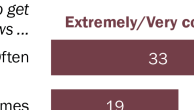Public Versus Private Ownership
Another issue embedded in the FCC debate, and even discussed among executives of some publicly owned companies, is whether private ownership allows for a greater chance of serving the public interest. The argument here, to oversimplify, is that being freed of the pressures of quarterly profit reports, focus on one’s stock price, and meeting industry based measures of profitability and efficiency, would allow companies to better focus on the long-term and on quality.
Our data, based on 54 privately held stations and 118 publicly held, suggest a slightly greater tendency toward quality at private companies, though the findings are not nearly as strong as in other ownership categories.
|
Public vs. Private Ownership
by Quality Grade |
||
| Grade |
Public Owner
|
Private Owner
|
| A |
15%
|
19%
|
| B |
31
|
35
|
| C |
31
|
24
|
| D |
18
|
13
|
| F |
5
|
9
|
| Total |
100%
|
100%
|
Overall, 19% of privately held stations in the markets studied earned “A’s”, versus 15% for publicly held stations. And 35% of privately held stations earned “B’s” compared with 31% for publicly held.
Private stations could also produce very poor quality. They were more inclined to “F’s” (9% versus 5%)–though less inclined to “D’s” (13% versus 18%).
The differences between these two ownership categories are much less than those we found for large versus small companies, O&O versus independently owned, and cross-owned versus others. In general, we think these differences are too small to conclusively support the argument that private ownership better serves the public interest than does public ownership.
What are the particular traits that differentiate privately versus publicly owned stations?
The differences, again, are less discernible than for other ownership categories.
Privately held stations demonstrate more of some kind of enterprise, for instance, and slightly less of others.
For many indicators, such as sourcing, focus on the important underlying trends in stories, the mix of viewpoints, there is little difference between public and private companies in our data.
Specifically:
- On Enterprise: Privately held stations were more likely than public company stations to send a reporter to the scene of a scheduled event (29% versus 24%). They were a little less likely to air wire stories or feeds from other sources (18% versus 21% for public). But on other indicators of enterprise, they scored slightly lower than public companies.
- On Localism: Publicly held stations tend a little more toward national stories that have no connection to viewing area (14% versus 11% for privately owned).
- On Story Length: Privately owned stations tended, by a small margin, to air fewer very short stories than publicly owned stations. Overall, 37% of the stories on private stations were 30-seconds or less in length, compared with 40% on publicly owned stations.




